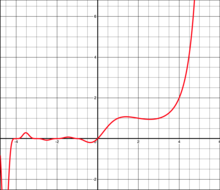Barnes G-function
In mathematics, the Barnes G-function G(z) is a function that is an extension of superfactorials to the complex numbers. It is related to the gamma function, the K-function and the Glaisher–Kinkelin constant, and was named after mathematician Ernest William Barnes.[1] It can be written in terms of the double gamma function.

Formally, the Barnes G-function is defined in the following Weierstrass product form:
where is the Euler–Mascheroni constant, exp(x) = ex, and ∏ is capital pi notation.
Functional equation and integer arguments
The Barnes G-function satisfies the functional equation
with normalisation G(1) = 1. Note the similarity between the functional equation of the Barnes G-function and that of the Euler gamma function:
The functional equation implies that G takes the following values at integer arguments:
(in particular, ) and thus
where denotes the gamma function and K denotes the K-function. The functional equation uniquely defines the G function if the convexity condition: is added.[2]
Value at
Reflection formula 1.0
The difference equation for the G-function, in conjunction with the functional equation for the gamma function, can be used to obtain the following reflection formula for the Barnes G-function (originally proved by Hermann Kinkelin):
The logtangent integral on the right-hand side can be evaluated in terms of the Clausen function (of order 2), as is shown below:
The proof of this result hinges on the following evaluation of the cotangent integral: introducing the notation for the logcotangent integral, and using the fact that , an integration by parts gives
Performing the integral substitution gives
The Clausen function – of second order – has the integral representation
However, within the interval , the absolute value sign within the integrand can be omitted, since within the range the 'half-sine' function in the integral is strictly positive, and strictly non-zero. Comparing this definition with the result above for the logtangent integral, the following relation clearly holds:
Thus, after a slight rearrangement of terms, the proof is complete:
Using the relation and dividing the reflection formula by a factor of gives the equivalent form:
Ref: see Adamchik below for an equivalent form of the reflection formula, but with a different proof.
Reflection formula 2.0
Replacing z with (1/2) − z'' in the previous reflection formula gives, after some simplification, the equivalent formula shown below (involving Bernoulli polynomials):
Taylor series expansion
By Taylor's theorem, and considering the logarithmic derivatives of the Barnes function, the following series expansion can be obtained:
It is valid for . Here, is the Riemann Zeta function:
Exponentiating both sides of the Taylor expansion gives:
Comparing this with the Weierstrass product form of the Barnes function gives the following relation:
Multiplication formula
Like the gamma function, the G-function also has a multiplication formula:[3]
where is a constant given by:
Here is the derivative of the Riemann zeta function and is the Glaisher–Kinkelin constant.
Asymptotic expansion
The logarithm of G(z + 1) has the following asymptotic expansion, as established by Barnes:
Here the are the Bernoulli numbers and is the Glaisher–Kinkelin constant. (Note that somewhat confusingly at the time of Barnes [4] the Bernoulli number would have been written as , but this convention is no longer current.) This expansion is valid for in any sector not containing the negative real axis with large.
Relation to the Loggamma integral
The parametric Loggamma can be evaluated in terms of the Barnes G-function (Ref: this result is found in Adamchik below, but stated without proof):
The proof is somewhat indirect, and involves first considering the logarithmic difference of the gamma function and Barnes G-function:
where
and is the Euler–Mascheroni constant.
Taking the logarithm of the Weierstrass product forms of the Barnes function and gamma function gives:
A little simplification and re-ordering of terms gives the series expansion:
Finally, take the logarithm of the Weierstrass product form of the gamma function, and integrate over the interval to obtain:
Equating the two evaluations completes the proof:
And since then,
References
- E. W. Barnes, "The theory of the G-function", Quarterly Journ. Pure and Appl. Math. 31 (1900), 264–314.
- M. F. Vignéras, L'équation fonctionelle de la fonction zêta de Selberg du groupe mudulaire SL, Astérisque 61, 235–249 (1979).
- I. Vardi, Determinants of Laplacians and multiple gamma functions, SIAM J. Math. Anal. 19, 493–507 (1988).
- E. T. Whittaker and G.N.Watson, "A course of modern analysis", CUP.
- Askey, R.A.; Roy, R. (2010), "Barnes G-function", in Olver, Frank W. J.; Lozier, Daniel M.; Boisvert, Ronald F.; Clark, Charles W. (eds.), NIST Handbook of Mathematical Functions, Cambridge University Press, ISBN 978-0-521-19225-5, MR 2723248
- Adamchik, Viktor S. (2003). "Contributions to the Theory of the Barnes function". arXiv:math/0308086.